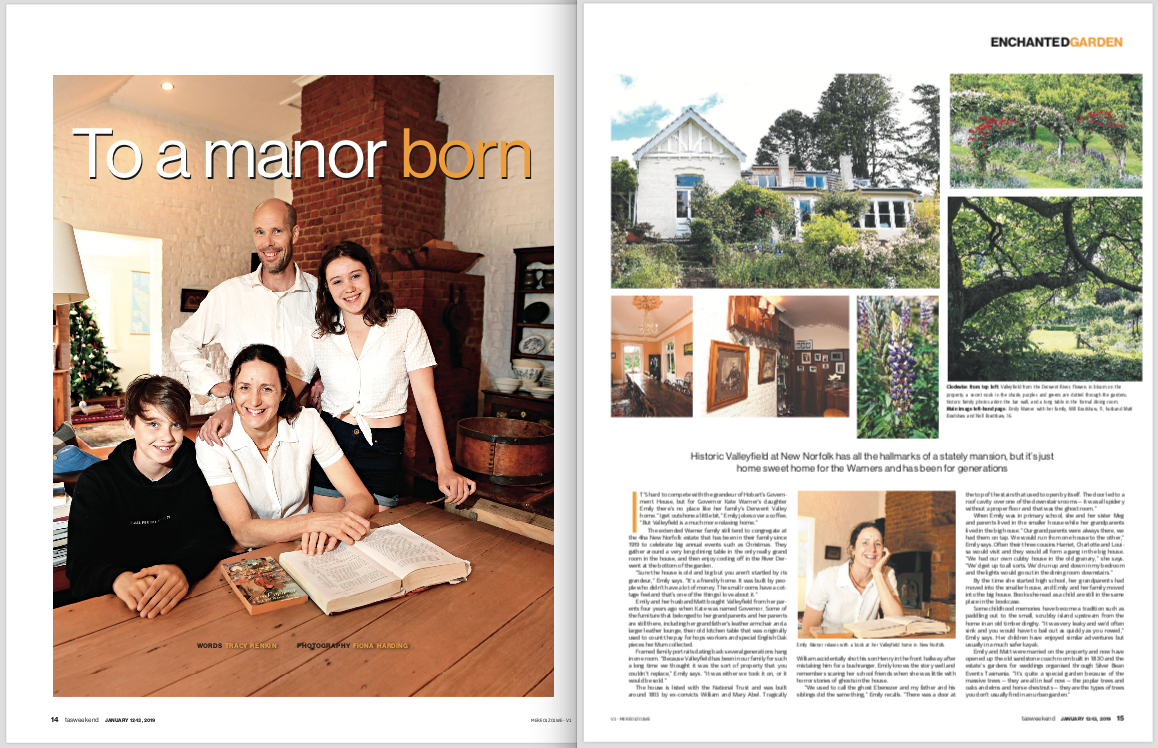To A Manor Born
First published in the TasWeekend magazine (The Hobart Mercury)

It’s hard to compete with the grandeur of government house, but for Governor Kate Warner’s daughter Emily there’s no place like her family’s far less grand Derwent Valley home. “I get outshone a little bit,” Emily jokes over a coffee. “But Valleyfield is a much more relaxing home.”
The extended Warner family still tend to congregate at the 10-acre New Norfolk estate that has been in their family since 1919 to celebrate big annual events like Christmas.
They gather around a very long dining room table in the only real grand room then enjoy cooling off in the Derwent river at the bottom of the garden. “Sure the house is old and big but you aren’t startled by it’s grandeur,” Emily says. “It’s a friendly home. It was built by people who didn’t have a lot of money. The small rooms have a cottage feel and that’s one of the things I love about it.”
Emily and her husband Matt bought Valleyfield off her parents four years ago when Kate was named governor. Some of the furniture that belonged to her grandparents and her parents are still there: her grandfather’s leather armchair and a larger leather lounge, their old kitchen table that was originally used to count the pay for hops workers and special English Oak pieces her Mum collected. Framed family portraits dating back several generations hang from the bar room.“Because Valleyfield has been in our family for such a long time we thought it was the sort of property that you couldn’t replace,” says Emily. “It was either we took it on, or it would be sold.”
The house is listed with the national trust and was built around 1813 by ex-convicts William and Mary Abel. Tragically William accidentally shot his son Henry in the front hallway after mistaking him for a bushranger. Emily knows the story well and remembers scaring her school friends when she was little with horror stories of ghosts in the house. “We used to call the ghost Ebenezer and my father and his siblings did the same thing,” Emily recalls. “There was a door at the top of the stairs that used to open by itself. The door lead to a roof cavity over one of the downstairs rooms - it was all spidery without a proper floor and that was the ghost room.”
When Emily was in primary school she and her sister Meg and parents lived in the smaller house while her grandparents lived in the big house. “Our grandparents were always there, we had them on tap. We would run from one house to the other,” Emily says. Often their three cousins Harriet, Charlotte and Louisa would visit and all us would form a gang in the big house. ”We had our own cubby house in the old grainery. We’d get up to all sorts. We’d run up an down in my bedroom and the lights would go out in the dining room downstairs.”
By the time she started high school, the grandparents had moved into the small house, and Emily and her family moved into the big house. Books she read as a child are still in the same place in the bookcase.
Some childhood memories have become a tradition like paddling out to the small, scrubby island upstream from the home in an old timber dinghy. “It was very leaky and we’d often sink and you would have to bail out as quickly as you rowed,” Emily remembers. Her children have enjoyed similar adventures but usually in a much safer kayak.
Emily and Matt were married on the property and now have opened up the old sandstone coach room built in 1830 and estate gardens for weddings organised through Silver Bean Events Tasmania. “It’s quite a special garden because of the massive trees - they are all in leaf now - the poplar trees and oaks and elms and horse chest nuts - they are the types of trees you don’t usually find in an urban garden.”
